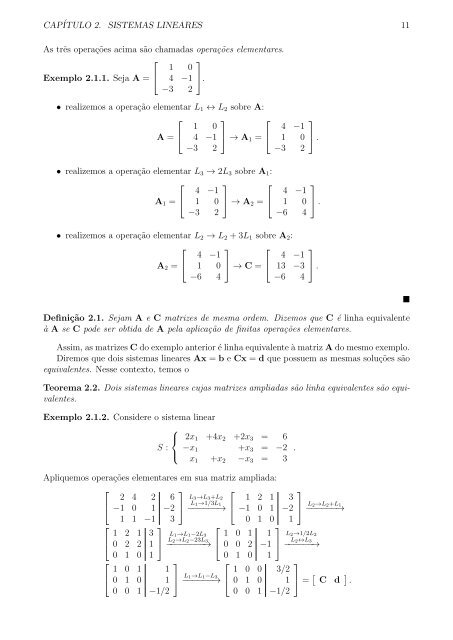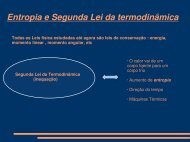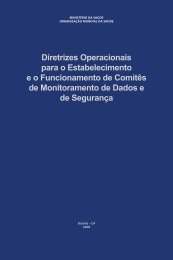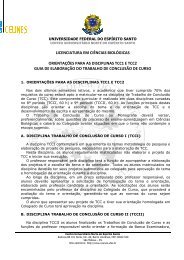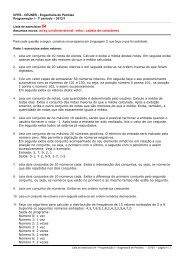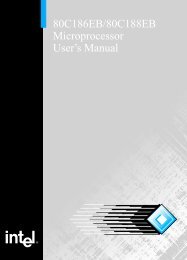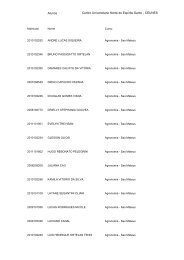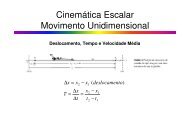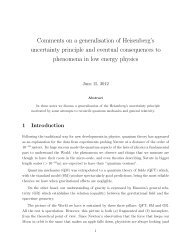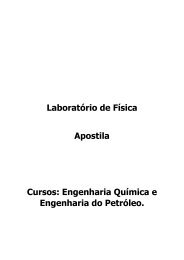ProgramaçËao Linear - Notas de aula - CEUNES
ProgramaçËao Linear - Notas de aula - CEUNES
ProgramaçËao Linear - Notas de aula - CEUNES
Create successful ePaper yourself
Turn your PDF publications into a flip-book with our unique Google optimized e-Paper software.
CAPÍTULO 2. SISTEMAS LINEARES 11As três operações acima são chamadas operações elementares.⎡1⎤0Exemplo 2.1.1. Seja A = ⎣ 4 −1 ⎦.−3 2• realizemos a operação elementar L 1 ↔ L 2 sobre A:⎡1⎤0⎡A = ⎣ 4 −1 ⎦ → A 1 = ⎣−3 2• realizemos a operação elementar L 3 → 2L 3 sobre A 1 :⎡4⎤−1⎡A 1 = ⎣ 1 0 ⎦ → A 2 = ⎣−3 24 −11 0−3 24 −11 0−6 4• realizemos a operação elementar L 2 → L 2 + 3L 1 sobre A 2 :⎡4⎤−1⎡4 −1A 2 = ⎣ 1 0 ⎦ → C = ⎣ 13 −3−6 4−6 4Definição 2.1. Sejam A e C matrizes <strong>de</strong> mesma or<strong>de</strong>m. Dizemos que C é linha equivalenteà A se C po<strong>de</strong> ser obtida <strong>de</strong> A pela aplicação <strong>de</strong> finitas operações elementares.Assim, as matrizes C do exemplo anterior é linha equivalente à matriz A do mesmo exemplo.Diremos que dois sistemas lineares Ax = b e Cx = d que possuem as mesmas soluções sãoequivalentes. Nesse contexto, temos oTeorema 2.2. Dois sistemas lineares cujas matrizes ampliadas são linha equivalentes são equivalentes.⎤⎦ .⎤⎦ .⎤⎦ .Exemplo 2.1.2. Consi<strong>de</strong>re o sistema linear⎧⎨ 2x 1 +4x 2 +2x 3 = 6S : −x 1 +x 3 = −2⎩x 1 +x 2 −x 3 = 3.Apliquemos operações elementares em sua matriz ampliada:⎡⎤ ⎡2 4 2 6 L 3 →L 3 +L 2 1 2 1 3L⎣ −1 0 1 −2 ⎦ 1 →1/3L 1−−−−−−→ ⎣ −1 0 1 −21 1 −1 30 1 0 1⎡⎣⎡⎣1 2 1 30 2 2 10 1 0 1⎤1 0 1 10 1 0 10 0 1 −1/2⎦ L 1→L 1 −2L 3L 2 →L 2 −23L 3⎡−−−−−−−−→ ⎣⎤⎡⎦ L 1→L 1 −L−−−−−−→3⎣1 0 1 10 0 2 −10 1 0 1⎤⎦1 0 0 3/20 1 0 10 0 1 −1/2⎤⎦ L 2→L 2 +L 1−−−−−−→L 2 →1/2L 2L 2 ↔L 3−−−−−−→⎤⎦ = [ C d ] .


